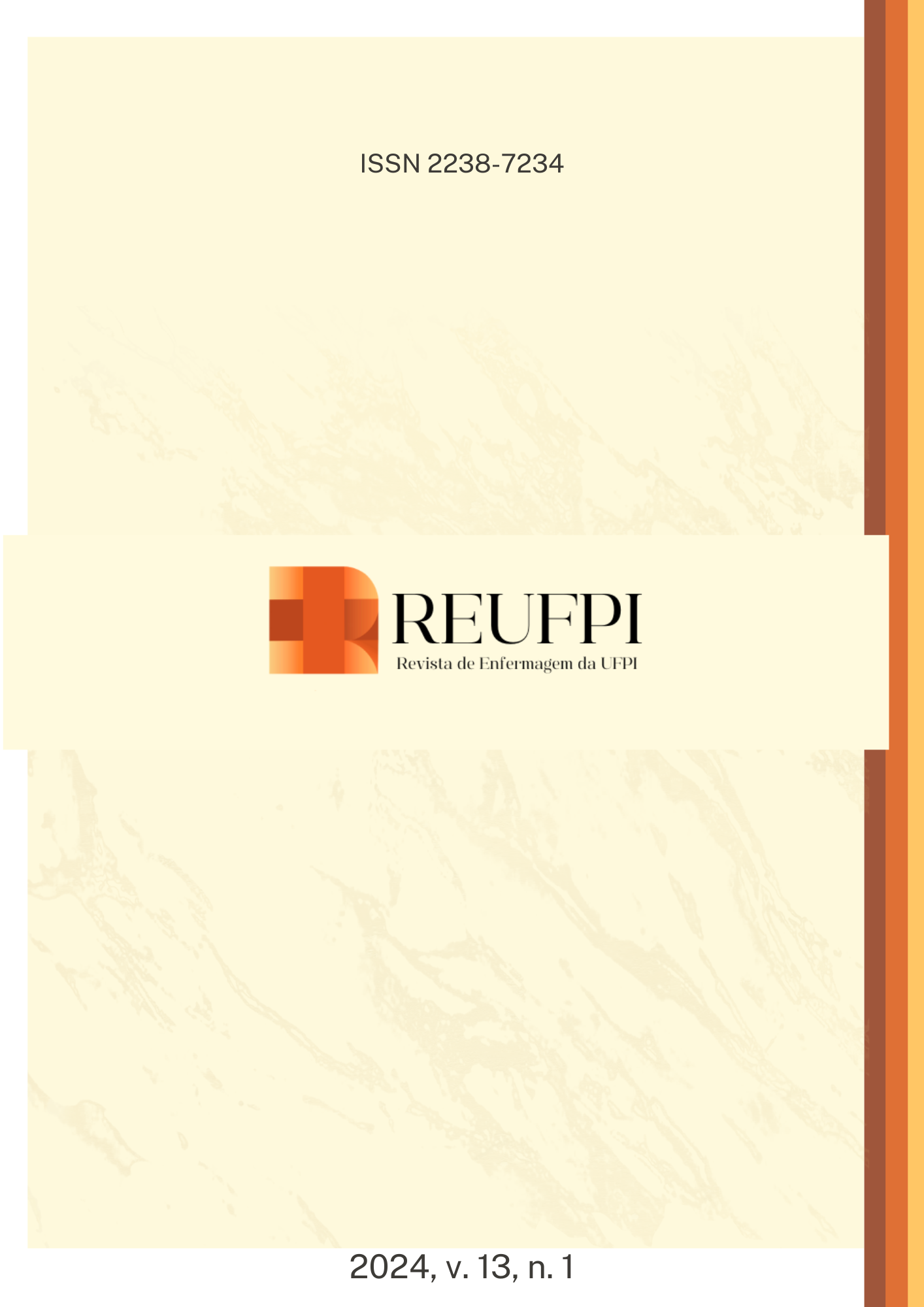Semantic validation of nursing outcome dry eye severity in intensive care
DOI:
https://doi.org/10.26694/reufpi.v13i1.4426Keywords:
Dry Eye Syndromes, Intensive Care Units, Evaluation of Patient Care Outcomes, Nursing Evaluation, Validation studiesAbstract
Objective: To semantically validate the indicators of the nursing outcome Dry Eye Severity in adult patients admitted to the intensive care unit. Methods: Methodological study of semantic validation developed with 15 nurses from an adult general ICU of a public university hospital located in the Northeast of Brazil. Data collection took place between the months of February and April 2019. For data analysis, the Kappa test was used with a value equal to or greater than 85% agreement. A value of p<0.05 was used to indicate statistical significance when the proportion was less than 85%. Results: After evaluating the nurses in relation to the constitutive and operational definitions and operational magnitudes of the indicators, all presented agreement ≥ 0.85. As all indicators that presented statistically significant p values (p < 0.05) presented a cutoff point with perfect agreement, all were admitted. In addition, the nurses' comments and suggestions were taken into account for the final version of the analysis. Conclusion: In the general evaluation of the NO Dry Eye Severity by the nurses, it was...
References
Ali S, Mohamed T, Mohamed M, Mahgoub A. Risk factors assessment of ocular surface disorders among adult critically ill patients. Assiut Sci Nurs J [Internet]. 2022;10(30): 220-31. doi: https://doi.org/10.21608/asnj.2022.133103.1360.
Shaeri M, Mahdian M, Akbari H, Azizzadeh Asl S. Incidence and related factors of surface eye disorders in traumatic intensive care unit patients in Iran. Int J Burns Trauma [Internet]. 2021 [cited 2022 Ago 28];11(4):344-9. Disponível em: https://www.ncbi.nlm.nih.gov/pmc/articles/PMC8449146/pdf/ijbt0011-0344.pdf.
Martínez-García JJ, Miranda-Hernández DR, Carlon-Rodrigo D. Incidencia de ojo seco y úlcera corneal en niños con ventilación mecánica tratados con bloqueo neuromuscular. Rev Mex Pediatr [Internet]. 2020;87(6): 207-11. doi: https://doi.org/10.35366/97681.
Machado A, Cruz I. Risk of eye dryness in intensive care unit: systematic review of literature. J Speci Nurs Care [Internet]. 2019 [cited 2022 Ago 29];11(1). Disponível em: http://www.jsncare.uff.br/index.php/jsncare/article/view/3131/791.
Herdman TH, Kamitsuru S, Lopez CT. Diagnósticos de enfermagem da NANDA-I: Definições e classificação 2021-2023. 12 ed. Porto Alegre: Artmed; 2021.
Moorhead S, Swanson E, Johnson M, Maas ML. Nursing Outcomes Classification (NOC). 5 ed. United States of America: Elsevier Mosby; 2018.
Butcher HK, Dochterman JM, Bulechek GM, Wagner CM. Classificação das intervenções de enfermagem (NIC). 7 ed. Rio de Janeiro: Editora Guanabara Koogan; 2020.
Moorhead S, Swanson E, Johnson M, Maas ML. Nursing Outcomes Classification (NOC). 6 ed. Rio de Janeiro: Editora Guanabara Koogan; 2020.
Araújo MG. Validação do resultado de enfermagem: gravidade do olho seco em pacientes adultos internados em Unidade de Terapia Intensiva. Natal. Tese [Doutorado em Enfermagem] - Centro de Ciências da Saúde, Universidade Federal do Rio Grande do Norte; 2020.
Pasquali L. Instrumentação psicológica: fundamentos e prática. 1 ed. São Paulo: Artmed; 2015.
Fernandes APNL, Araújo JNM, Botarelli FR, Pitombeira DO, Ferreira Júnior MA, Vitor AF. Dry Eye Syndrome in Intensive Care Units: a concept analysis. Rev Bras Enferm [Internet]. 2018;71(3):1162-9. doi: https://doi.org/10.1590/0034-7167-2016-0582.
Lopes MVO, Silva VM, Araújo TL. Methods for Establishing the Accuracy of Clinical Indicators in Predicting Nursing Diagnoses. Intern J of Nursing Knowledge [Internet]. 2012;23(3): 134-9. doi: https://doi.org/10.1111/j.2047-3095.2012.01213.x.
Santos FC. Construção e validação semântica de um instrumento para competências de enfermeiros que atuam na oncologia. Ribeirão Preto. Dissertação [Mestrado em Ciências] - Escola de Enfermagem de Ribeirão Preto, Universidade de São Paulo; 2016.
Marinho PML, Campos MPA, Rodrigues EOL, Gois CFL, Barreto IDC. Construção e validação de instrumento de avaliação do uso de Tecnologias Leves em Unidades de Terapia Intensiva. Rev Lat Am Enfermagem [Internet]. 2016; 24(1):e2816. doi: https://doi.org/10.1590/1518-8345.1002.2816.
Tsubota K, Yokoi N, Watanabe H, Dogru M, Kojima T, Yamada M, et al. A New Perspective on Dry Eye Classification: Proposal by the Asia Dry Eye Society. Eye Contact Lens [Internet]. 2020;46 Suppl 1(1):S2-S13. doi: https://doi.org/10.1097/ICL.0000000000000643.
Akpek EK, Amescua G, Farid M, Garcia-Ferrer FJ, Lin A, Rhee MK, et al. Dry Eye Syndrome Preferred Practice Pattern®. Ophthalmol [Internet]. 2019;126(1):P286-P334. doI: https://doi.org/10.1016/j.ophtha.2018.10.023.
Brissette AR, Drinkwater OJ, Bohm KJ, Starr CE. The utility of a normal tear osmolarity test in patients presenting with dry eye disease like symptoms: A prospective analysis. Cont Lens Anterior Eye [Internet]. 2019;42(2):185-9. doi: https://doi.org/10.1016/j.clae.2018.09.002.
Güler EK, Eşer İ, Fashafsheh IHD. Intensive Care Nurses' Views and Practices for Eye Care: An International Comparison. Clin Nurs Res [Internet]. 2017;26(4):504-24. doI: https://doi.org/10.1177/1054773816631471.
Płaszewska-Żywko L, Sega A, Bukowa A, Wojnar-Gruszka K, Podstawa M, Kózka M. Risk Factors of Eye Complications in Patients Treated in the Intensive Care Unit. Int J Environ Res Public Health [Internet]. 2021; 18(21):11178. doi: https://doi.org/10.3390/ijerph182111178.
Walter K. What Is Dry Eye Disease? JAMA [Internet]. 2022;328(1):84. doi: https://doi.org/10.1001/jama.2022.5978.
Pourghaffari Lahiji A, Gohari M, Mirzaei S, Nasiriani K. The effect of implementation of evidence-based eye care protocol for patients in the intensive care units on superficial eye disorders. BMC Ophthalmol [Internet]. 2021;21:275. doi: https://doi.org/10.1186/s12886-021-02034-x.
Araújo JNM, Fernandes APNL, Silva HP, Pitombeira DO, Júnior MAF, Vitor AF. Olho seco e doenças da córnea em pacientes internados em terapia intensiva [Internet]. Rev Cubana Enfermer. 2018;34(2). Disponível em: http://revenfermeria.sld.cu/index.php/enf/article/view/1596/361.
Araújo JNM, Botarelli FR, Fernandes APNL, Oliveira-Kumakura ARS, Ferreira Junior MA, Vitor AF. Predictive clinical factors for ocular dryness in patients admitted to the Intensive Care Unit. Rev Esc Enferm USP [Internet]. 2019;53:e03493. doi: https://doi.org/10.1590/S1980-220X2018036603493.
Sullivan DA. TFOS DEWS II Epidemiology and Pathophysiology Reports. Acta Ophthalmol [Internet]. 2018;96(261):120-1. doi: https://doi.org/10.1111/aos.13972_451.
Araújo DD, Silva DVA, Rodrigues CAO, Silva PO, Macieira TGR, Chianca TCM. Effectiveness of Nursing Interventions to Prevent Dry Eye in Critically Ill Patients. Am J Crit Care [Internet]. 2019;28(4):299-306. doi: https://doi.org/10.4037/ajcc2019360.
Soares RP da S, Fernandes APN de L, Botarelli FR, Araújo JN de M, Olímpio J de A. Indicadores clínicos do Resultado de Enfermagem Gravidade do Olho Seco em unidade de terapia intensiva. Rev. Lat Am Enferm [Internet]. 2019;27(e3181):e3201. doi: https://doi.org/10.1590/1518-8345.2983.3201.
Dana R, Bradley JL, Guerin A, Pivneva I, Evans AM, Stillman IÖ. Comorbidities and Prescribed Medications in Patients With or Without Dry Eye Disease: A Population-Based Study. Am J Ophthalmol [Internet]. 2019;198:181-192. doi: https://doi.org/10.1016/j.ajo.2018.10.001.
Płaszewska-Żywko L, Sega A, Bukowa A, Wojnar-Gruszka K, Podstawa M, Kózka M. Risk Factors of Eye Complications in Patients Treated in the Intensive Care Unit. Int J Environ Res Public Health. 2021;18(21):11178.
Yu K, Bunya V, Maguire M, Asbell P, Ying GS; Dry Eye Assessment and Management Study Research Group. Systemic Conditions Associated with Severity of Dry Eye Signs and Symptoms in the Dry Eye Assessment and Management Study. Ophthalmology [Internet]. 2021;128(10):1384-92. doi: https://doi.org/10.1016/j.ophtha.2021.03.030.
Mobarez F, Sayadi N, Jahani S, Sharhani A, Savaie M, Farrahi F. The effect of eye care protocol on the prevention of ocular surface disorders in patients admitted to intensive care unit. J Med Life [Internet]. 2022;15(8):1000-4. doi: https://doi.org/10.25122/jml-2022-0139.
Downloads
Published
How to Cite
Issue
Section
License
Copyright (c) 2024 Rev Enferm UFPI

This work is licensed under a Creative Commons Attribution 4.0 International License.
Autores mantém os direitos autorais e concedem à REUFPI o direito de primeira publicação, com o trabalho licenciado sob a Licença Creative Commons Attibution BY 4.0 que permite o compartilhamento do trabalho com reconhecimento da autoria e publicação inicial nesta revista.






